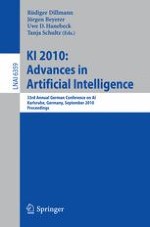The 33rd Annual German Conference on Arti?cial Intelligence (KI 2010) took place at the Karlsruhe Institute of Technology KIT, September 21–24, 2010, under the motto “Anthropomatic Systems.” In this volume you will ?nd the keynote paper and 49 papers of oral and poster presentations. The papers were selected from 73 submissions, resulting in an acceptance rate of 67%. As usual at the KI conferences, two entire days were allocated for targeted workshops—seventhis year—andone tutorial. The workshopand tutorialma- rials are not contained in this volume, but the conference website, www.ki2010.kit.edu,will provide information and references to their contents. Recent trends in AI research have been focusing on anthropomatic systems, which address synergies between humans and intelligent machines. This trend is emphasized through the topics of the overall conference program. They include learning systems, cognition, robotics, perception and action, knowledge rep- sentation and reasoning, and planning and decision making. Many topics deal with uncertainty in various scenarios and incompleteness of knowledge. Summarizing, KI 2010 provides a cross section of recent research in modern AI methods and anthropomatic system applications. We are very grateful that Jos´ edel Mill´ an, Hans-Hellmut Nagel, Carl Edward Rasmussen, and David Vernon accepted our invitation to give a talk.
